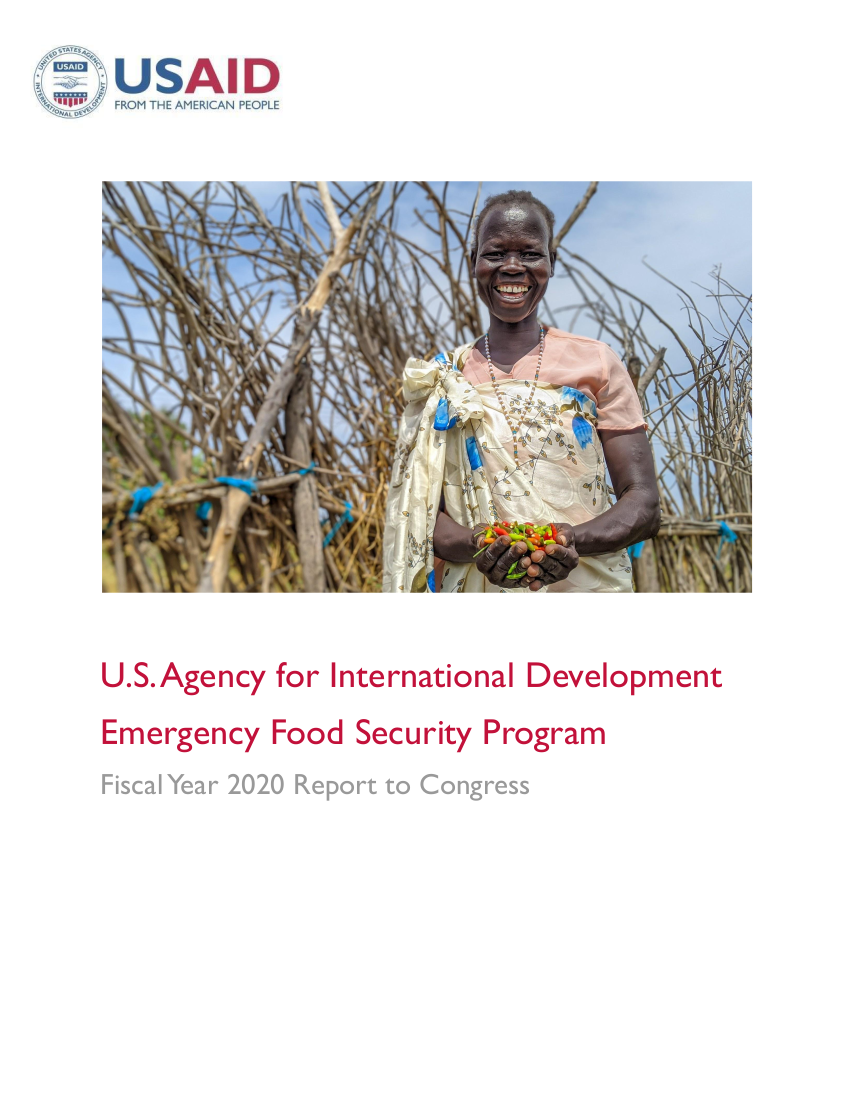Speeches Shim
This report is submitted pursuant to the Global Food Security Act of 2016 (P.L. 114-195), which amended Section 492 of the Foreign Assistance Act of 1961 (22 U.S.C. 2292(c)). The report describes how the U.S. Agency for International Development (USAID) used Fiscal Year (FY) 2020 International Disaster Assistance (IDA) funding, through the Emergency Food Security Program (EFSP), to address food insecurity in emergency situations using market-based approaches, including local, regional, and international procurement (LRIP), and cash and voucher assistance for food.
Purpose and Program Objectives
The USAID Bureau for Humanitarian Assistance (BHA) delivers two main types, or categories, of food assistance abroad: 1) Agricultural commodities from the United States authorized in Title II of the Food for Peace Act (7 U.S.C. 1691 et seq.), and 2) Market-based food assistance and essential complementary activities, authorized in both the Food for Peace Act and the Foreign Assistance Act of 1961 as amended.
USAID began using market-based food assistance through the IDA account in FY 2010. The program was formally authorized as the EFSP in Section 7 of the Global Food Security Act of 2016 and was reauthorized in 2018 by the Global Food Security Reauthorization Act of 2017 (P.L. 115-266).
The Global Food Security Act states the purpose of the EFSP is “to mitigate the effects of manmade and natural disasters by utilizing innovative new approaches to delivering aid that support affected persons and the communities hosting them, build resilience and early recovery, and reduce opportunities for waste, fraud and abuse.” Congress has authorized funding for the EFSP through Fiscal Year 2023.
Market-based modalities include local, regional, and international food procurement; cash transfers for food; and food vouchers. USAID determines which method, or “modality”, to employ in a given context using four criteria: market appropriateness, feasibility, project objectives, and cost. LRIP commodities should reinforce developing markets to the greatest extent possible, emphasizing local and regional commodity sources.
Fiscal Year 2020 Assistance
In 2020, levels of acute hunger remained high around the globe with an estimated 113 million people across 46 countries projected to need emergency food assistance, according to the Famine Early Warning Systems Network (FEWS NET). Global hunger has been increasing since 2016, in part driven by conflict and insecurity in countries such as Syria, South Sudan, and Somalia.
The novel coronavirus SARS-CoV2, also known as COVID-19, and measures to contain it caused widespread disruptions in both global and local food markets and supply chains—leading to system-wide impacts on food security. USAID has tracked, and continues to track, the impact on food insecurity resulting from COVID-19 and has worked with partners to adapt existing food assistance programs to fit local needs and improve COVID-19 readiness and recovery efforts around the world.
Before the pandemic, two primary factors drove increases in global food insecurity over the last several years. The first was the persistence of multiple, large-scale conflicts that disrupted markets and livelihoods and caused widespread displacement and insecurity. In FY 2020, the United States continued to provide large-scale emergency food assistance in the context of crises, such as those in Syria and South Sudan. The second factor affecting global food insecurity, including in FY 2020, was the recurrence of climatic shocks or extreme weather patterns. In the Horn of Africa, the effects of persistent conflict were compounded by severe drought in FY 2019 and significant flooding in FY 2020, exacerbating humanitarian needs in Somalia and Ethiopia that continued into FY 2020.
In FY 2020, USAID provided more than $2.88 billion in EFSP assistance reaching nearly 44 million people in 52 countries. Combined with Title II and Development Assistance funds (referred to as Community Development funds), USAID reached more than 71 million people in 57 countries with a total of approximately $4.8 billion in food assistance. LRIP accounted for more than 42 percent of EFSP programming in FY 2020. Food vouchers accounted for 26 percent and cash transfers accounted for nearly 27 percent of FY 2020 programming. Essential complementary activities and other related activities accounted for 5 percent of EFSP funding. For a detailed list of all country specific EFSP activities for FY 2020, see Appendix B.
Last updated: April 19, 2021


Comment
Make a general inquiry or suggest an improvement.